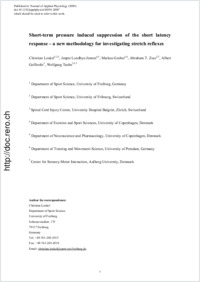Short-term pressure induced suppression of the short latency response - a new methodology for investigating stretch reflexes
- Leukel, Christian Department of Sport Science, University of Freiburg, Germany - Department of Sport Science, University of Fribourg, Switzerland - Spinal Cord Injury Centre, University Hospital Balgrist, Zürich, Switzerland
- Lundbye-Jensen, Jesper Department of Exercise and Sport Sciences, University of Copenhagen, Denmark - Department of Neuroscience and Pharmacology, University of Copenhagen, Denmark
- Gruber, Markus Department of Sport Science, University of Freiburg, Germany - Department of Training and Movement Science, University of Potsdam, Germany
- Zuur, Abraham T. Department of Neuroscience and Pharmacology, University of Copenhagen, Denmark - Center for Sensory-Motor Interaction, Aalborg University, Denmark
- Gollhofer, Albert Department of Sport Science, University of Freiburg, Germany
- Taube, Wolfgang Department of Sport Science, University of Freiburg, Germany - Department of Sport Science, University of Fribourg, Switzerland - Spinal Cord Injury Centre, University Hospital Balgrist, Zürich, Switzerland
-
20.08.2009
Published in:
- Journal of Applied Physiology. - 2009, vol. 107, no. 4, p. 1051-1058
English
During experiments involving ischemic nerve block we noticed that the short latency response (SLR) of evoked stretches in m. soleus decreased immediately following inflation of a pneumatic cuff surrounding the lower leg. The present study aimed to investigate this short-term effect of pressure application in more detail. 58 healthy subjects were divided into 7 protocols. Unilateral stretches were applied to the calf muscles to elicit an SLR, bilateral stretches to evoke a subsequent medium latency response (MLR). Furthermore, H-reflexes and sensory nerve action potentials (SNAPs) were recorded. Additionally, stretches were applied with different velocities and amplitudes. Finally, the SLR was investigated during hopping and in 2 protocols that modified the ability of the muscle-tendon complex distal to the cuff to stretch. All measurements were performed with deflated and inflated cuff. Results of the protocols were: a) inflation of the cuff reduced the SLR but not the MLR, b) the H-reflex, the M-wave, and, c) SNAPs of n. tibialis remained unchanged with deflated and inflated cuff, d) the SLR was dependent on the stretch velocity with deflated and also inflated cuff, e-f) the reduction of the SLR by the cuff was dependent on the elastic properties of the muscle-tendon complex distal to the cuff, and g) the cuff reduced the SLR during hopping. The present results suggest that the cuff did not affect the reflex arc per se. It is proposed that inflation restricted stretch of the muscles underlying the cuff so that most of the length change occurred in the muscle-tendon complex distal to the cuff. As a consequence, the muscle spindles lying within the muscle may be less excited resulting in a reduced SLR. Due to its applicability in functional tasks, the introduced method can be a useful tool to study afferent feedback in motor control.
- Faculty
- Faculté des sciences et de médecine
- Department
- Département de Médecine
- Language
-
- English
- Classification
- Biological sciences
- License
- License undefined
- Identifiers
-
- RERO DOC 12642
- DOI 10.1152/japplphysiol.00301.2009
- Persistent URL
- https://folia.unifr.ch/unifr/documents/301264
Statistics
Document views: 76
File downloads:
- leukel_stp.pdf: 152
